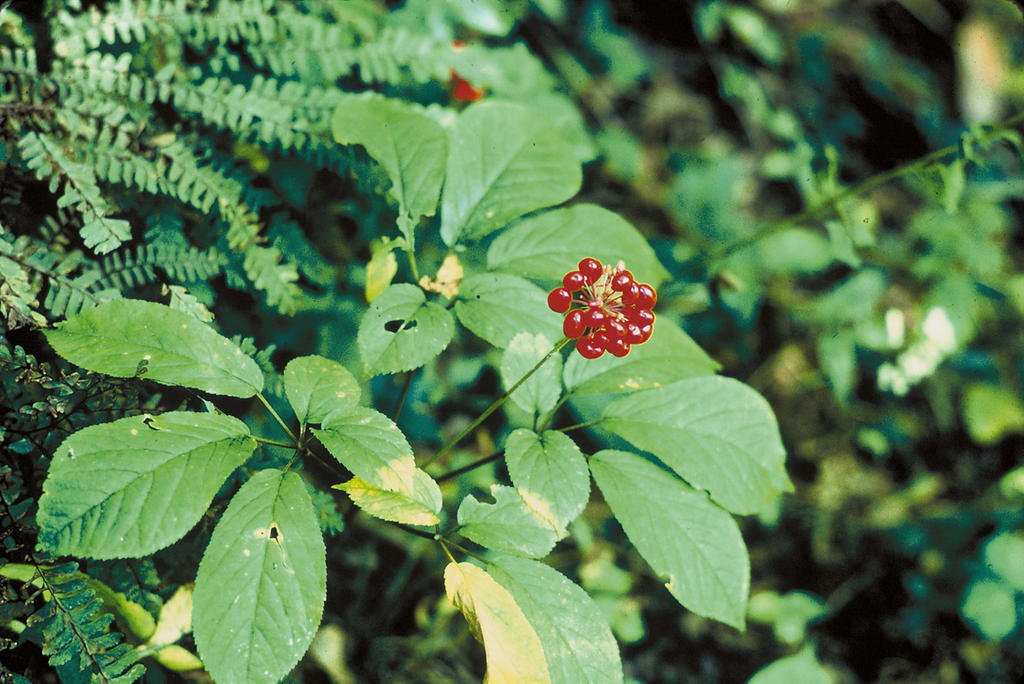- American Ginseng
Taxobox
name = American Ginseng

image_width = 240px
image_caption = "Panax quinquefolius" foliage and fruit
status = G3
status_system = TNC
status_ref = Cite web
publisher =NatureServe
title = Panax quinquefolius
work = NatureServe Explorer
url = http://www.natureserve.org/explorer/servlet/NatureServe?searchName=Panax+quinquefolius+
accessdate = 2007-07-03]
regnum =Plant ae
divisio = Magnoliophyta
classis =Magnoliopsida
ordo =Apiales
familia =Araliaceae
subfamilia =Aralioideae
genus = "Panax "
species = "P. quinquefolius"
binomial = "Panax quinquefolius"
binomial_authority = L."Panax quinquefolius", commonly known as American Ginseng and often by its Chinese name "Huaqishen" (zh-stp|s=花旗参|t=花旗參|p=huāqíshēn;
Jyutping : faa1kei4sam1; zh-l|fancy flag (American) ginseng) or "Xiyangshen" (zh-stp|s=西洋参|t=西洋參|p=xīyángshēn;Jyutping : sai1joeng4sam1; zh-l|west ocean ginseng), is an herbaceous perennial in the ivy family that is commonly used in medicine. It is native to easternNorth America , though it also cultivated beyond its range in places such asChina . Citation
last =Xiang
first =Qibai; Lowry P., Porter
contribution =Panax quinquefolius
year =2007
title =Flora of China
editor-last =Wu
editor-first =Z. Y.; Raven, P.H.; Hong, D.Y.
volume =13
pages =491
place=Beijing
publisher =Science Press; St. Louis: Missouri Botanical Garden Press
contribution-url = http://www.efloras.org/florataxon.aspx?flora_id=2&taxon_id=200015253
accessdate = 2007-07-03
id = ]The plant's forked root and leaves were traditionally used for medicinal purposes by Native Americans. Since the 1800s, the roots have been collected by "'sang hunters," and sold to Chinese or Hong Kong traders, who often pay very high prices for particularly old wild roots. [http://www.research.vt.edu/resmag/2002summer/forestproducts.html] American Ginseng was formerly particularly widespread in the Appalachian and Ozark regions (and adjacent forested regions such as
Pennsylvania and New York State), but due its popularity the wild plant has been overharvested, and is thus rare in most parts of the United States. [http://www.rps.psu.edu/pennsylvania/ginseng.html] It is also grown commercially, under artificial shade, in fields inWisconsin andMinnesota , and usually harvested after three to four years when ripe. [http://www.rps.psu.edu/pennsylvania/ginseng.html] Many ginseng growers in Wisconsin are represented by the "Ginseng Board of Wisconsin" [http://www.ginsengboard.com/] , whose seal is often sought after on ginseng products to certify they are genuine.Chemical components
Like
Panax ginseng , American ginseng contains dammarane typeginsenosides as the major biologically active constituents. Dammarane type ginsenosides includes 2 classifications: the 20(S)-protopanaxadiol [ppd] and 20(S)-protopanaxatriol [ppt] classifications. American ginseng contains high levels of Rb1, Rd (ppd classification) and Re (ppt classification) ginsenosides -- higher than that of P. ginseng in one study. cite journal
author=Shu Zhu "et al"
title=Comparative study on triterpene saponins of ginseng drugs
journal=Planta medica
year=2004
volume=70
issue=7
pages=666–677
pmid = 15303259
doi=10.1055/s-2004-827192]Pharmacokinetics
When taken orally, ppd-type ginsenosides are mostly metabolized by intestinal bacteria (
anaerobes ) to ppd monoglucoside, 20-O-beta-D-glucopyranosyl-20(S)-protopanaxadiol (M1). cite journal
author=Hasegawa H "et al"
title=Main ginseng saponin metabolites formed by intestinal bacteria
journal=Planta medica
year=1996
volume=62
issue=5
pages=453–457
pmid = 8923812
doi=10.1055/s-2006-957938] In humans, M1 is detected in plasma from 7 hours after the intake of ppd-type ginsenosides and in urine from 12 hours after the intake. These findings indicate that M1 is the final metabolite of ppd-type ginsenosides.cite journal
author=Tawab MA "et al"
title=Degradation of ginsenosides in humans after oral administration
journal=Drug metabolism and disposition
year=2003
volume=31
issue=8
pages=1065–1071
pmid = 12867496
doi=10.1124/dmd.31.8.1065]M1 is referred to in some articles as IH-901cite journal
author=Oh SH "et al"
title=A ginseng saponin metabolite-induced apoptosis in HepG2 cells involves a mitochondria-mediated pathway and its downstream caspase-8 activation and Bid cleavage
journal=Toxicology and Applied Pharmacology
year=2004
volume=194
issue=3
pages=221–229
pmid = 14761678
doi=10.1016/j.taap.2003.09.011] , and in others as compound-K.cite journal
author=Tawab MA "et al"
title=Degradation of ginsenosides in humans after oral administration
journal=Drug metabolism and disposition
year=2003
volume=31
issue=8
pages=1065–1071
pmid = 12867496
doi=10.1124/dmd.31.8.1065]References
External links
* [http://www.research.vt.edu/resmag/2002summer/forestproducts.html "There is More to a Forest than Trees"] by Lynn Davis, College of Natural Resources, Virginia Tech
* [http://www.rps.psu.edu/pennsylvania/ginseng.html "Roots and Regulations: The Unfolding Story of Pennsylvania Ginseng"] , by Melissa Beattie-Moss
Wikimedia Foundation. 2010.
